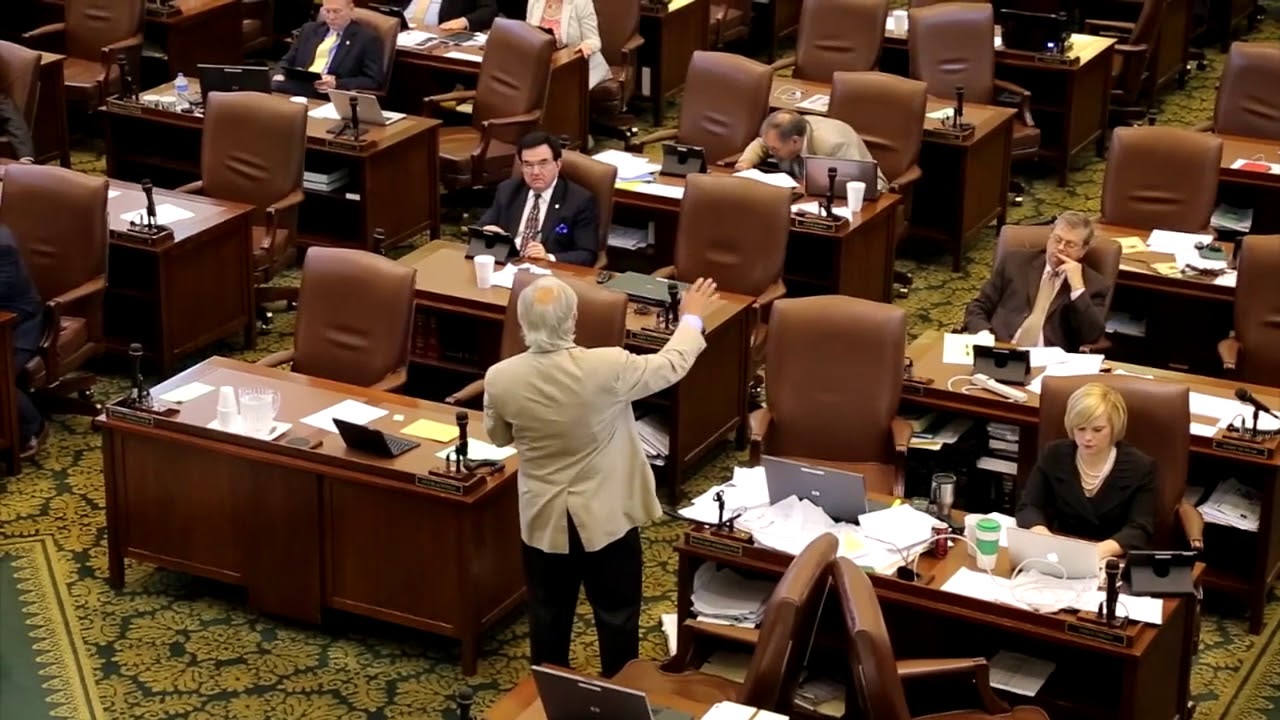

Finance
How Many States Offer Financial Education
Modified: January 5, 2024
Discover how many states in the US offer financial education and learn about the importance of finance in today's society. Expand your knowledge and make informed financial decisions.
(Many of the links in this article redirect to a specific reviewed product. Your purchase of these products through affiliate links helps to generate commission for LiveWell, at no extra cost. Learn more)
Table of Contents
Introduction
Financial education plays a vital role in empowering individuals to make informed decisions about their money and achieve financial well-being. With proper financial knowledge, individuals can better manage their finances, plan for the future, and navigate the complexities of the financial world.
However, the level of financial education varies significantly across different regions and states. While some states prioritize financial literacy and provide comprehensive financial education programs, others lag behind in providing such opportunities. In this article, we will explore how many states currently offer financial education, the factors influencing its availability, the challenges in implementing financial education programs, and the impact and benefits of financial education.
As of now, around 45 states in the United States have some form of financial education requirement in their curriculum. These requirements can vary in terms of the depth and scope of financial education offered. Some states may have standalone personal finance courses, while others integrate financial education into existing subjects such as math or economics.
The availability of financial education in each state is influenced by a variety of factors. One crucial factor is the state’s education policies and priorities. States that prioritize financial literacy are more likely to have comprehensive financial education programs in place. Additionally, the level of funding allocated to education, the support from policymakers and stakeholders, and the involvement of community organizations all contribute to the availability of financial education.
Implementing financial education programs presents several challenges. One major challenge is the lack of qualified teachers to deliver financial education content. Many teachers may not have the necessary training or expertise in personal finance to effectively educate students in this area. Additionally, there may be resistance or competing priorities within the education system that hinder the implementation of financial education programs.
Despite these challenges, financial education has a significant impact on individuals and society as a whole. Studies have shown that individuals with higher levels of financial literacy are more likely to make wise financial decisions, save for retirement, and avoid excessive debt. Financially literate individuals are also better equipped to handle unexpected financial challenges and have a greater understanding of basic financial concepts.
State-by-State Financial Education
The level of financial education offered by each state varies, with some states prioritizing comprehensive financial literacy programs, while others have more limited offerings. Let’s take a closer look at the state-by-state breakdown of financial education in the United States.
At present, around 45 states have incorporated financial education into their curriculum, with varying requirements and approaches. Some states mandate standalone personal finance courses, while others integrate financial education into subjects like math, economics, or social studies.
States such as Alabama, Arizona, and Utah require a standalone personal finance course for high school graduation, ensuring that students are equipped with essential financial knowledge before entering adulthood. Other states, like California and Texas, have integrated financial education into their existing curriculum, ensuring that students receive a comprehensive financial education across various subjects.
Even states without specific requirements for financial education often encourage its inclusion in schools. While not mandatory, schools in these states have the flexibility to incorporate financial education into their curriculum if they see fit. This provides an opportunity for educators to introduce financial literacy concepts and skills to students.
However, it’s essential to note that the depth and quality of financial education can still vary within states. Some states may have minimal or outdated financial literacy standards, while others have comprehensive and up-to-date standards that cover a wide range of topics, such as budgeting, saving, investing, and consumer protection.
While progress has been made in expanding financial education across states, there is still room for improvement. Several states are actively working to enhance financial education initiatives, updating their standards, and collaborating with educators and organizations to develop engaging and effective financial literacy programs.
Moreover, the availability of financial education resources and training for teachers can also impact the quality and delivery of financial education. States that provide ongoing professional development opportunities and resources for educators are better equipped to deliver high-quality financial education that meets the needs of their students.
Efforts are also being made to address the gap in financial education at the elementary and middle school levels. Recognizing the importance of early financial education, some states are integrating financial literacy concepts into their standards for younger grades, ensuring that students develop a strong foundation in financial knowledge from an early age.
In summary, while financial education is not yet a universal requirement in every state, progress has been made in expanding its availability. The depth and quality of financial education can vary significantly between states, with some states taking a more comprehensive approach while others have more limited requirements. Ongoing efforts are being made to enhance financial education initiatives and ensure that students across the country receive the necessary knowledge and skills to make informed financial decisions.
Factors Influencing Financial Education Availability
The availability of financial education in each state is influenced by various factors that shape the educational landscape and priorities. Understanding these factors is essential for assessing the progress and challenges in expanding financial education initiatives. Here are some key factors that influence the availability of financial education:
- State Education Policies and Priorities: The education policies and priorities set by each state play a crucial role in determining the emphasis placed on financial education. States with a clear commitment to financial literacy are more likely to have comprehensive financial education standards and requirements.
- Funding for Education: The level of funding allocated to education can impact the availability of financial education programs. Adequate funding allows for the development of curricula, training of teachers, and provision of educational resources needed to deliver effective financial education.
- Support from Policymakers and Stakeholders: The support and commitment of policymakers, school administrators, and other stakeholders are vital in promoting and implementing financial education initiatives. When these key players recognize the importance of financial education, they are more likely to advocate for its inclusion and allocate resources to support its implementation.
- Teacher Training and Expertise: The availability of qualified teachers who are trained in financial literacy is crucial for effective financial education. Many teachers may not receive specific training in personal finance, leading to a gap in their ability to deliver comprehensive financial education to students. Providing professional development opportunities and resources for teachers can help bridge this gap and improve the quality of financial education.
- Community Organization Involvement: Collaborations between schools and community organizations can significantly enhance the availability and impact of financial education. Community organizations often have specialized expertise and resources that can complement school-based efforts and provide additional support and engagement opportunities for students and families.
These factors interact with one another, influencing the availability and quality of financial education programs. States that prioritize financial literacy, allocate sufficient funding, provide teacher training, and engage with community organizations are more likely to have robust financial education offerings. On the other hand, states facing resource constraints, competing priorities, or lack of supportive policies may struggle to provide comprehensive financial education to their students.
Recognizing the importance of financial education, many states are actively working to address these factors and enhance the availability of financial education programs. Efforts are being made to revise and update financial literacy standards, provide professional development opportunities for teachers, and foster collaborations between schools and community organizations. By addressing these influencing factors, states can create an environment that supports and promotes widespread financial education for all students.
Challenges in Implementing Financial Education Programs
While the importance of financial education is widely recognized, implementing effective and sustainable financial education programs can come with various challenges. These challenges can hinder the widespread adoption and successful implementation of financial education initiatives. Here are some common challenges in implementing financial education programs:
- Lack of Qualified Teachers: One significant challenge is the lack of qualified teachers with expertise in personal finance. Many educators may not have received specific training in financial literacy, which can limit their ability to effectively teach students about complex financial concepts. Adequate training, professional development opportunities, and resources for teachers are necessary to bridge this gap and ensure the delivery of high-quality financial education.
- Competing Priorities: Financial education may struggle to receive the necessary attention and resources within the education system, as schools and educators juggle multiple priorities. With a packed curriculum and other mandated subjects, financial education can sometimes be seen as an additional burden. Integration of financial education into existing subjects or identification of cross-curricular opportunities can help address this challenge.
- Lack of Time: Limited instructional time poses a challenge in delivering comprehensive financial education. Schools face time constraints, and teachers may feel pressured to cover a wide range of topics within a limited timeframe. Effective planning and prioritization of financial education topics can help ensure that key concepts and skills are adequately addressed within the available time.
- Access to Quality Resources: Access to high-quality resources, such as textbooks, educational materials, and digital tools, can significantly impact the effectiveness of financial education. Some schools or districts may not have access to up-to-date resources or may lack the financial means to acquire them. Investing in quality resources and leveraging technology can enhance the learning experience and engagement of students.
- Evaluation and Assessment: Assessing the effectiveness and impact of financial education programs can be challenging. Measuring students’ outcomes and understanding whether they are acquiring the necessary financial knowledge and skills can be complex. Developing appropriate evaluation methods and tools is crucial to ensure the ongoing improvement and effectiveness of financial education initiatives.
These challenges are not insurmountable, and many states and organizations are actively working to address them. Efforts are being made to provide professional development opportunities for teachers, develop comprehensive curricula and resources, and integrate financial education into existing subjects to overcome some of these challenges.
Moreover, collaboration between educational institutions, policymakers, community organizations, and the private sector can help address these challenges and create a supportive environment for the successful implementation of financial education programs. By working together, stakeholders can pool their resources, expertise, and knowledge to overcome barriers and ensure that financial education becomes an integral part of every student’s education.
Impact and Benefits of Financial Education
Financial education has a profound impact on individuals and society as a whole. By equipping individuals with the knowledge and skills to make informed financial decisions, financial education provides numerous benefits. Here are some of the key impacts and benefits of financial education:
- Improved Financial Decision-Making: Financial education empowers individuals to make better financial choices. By understanding concepts such as budgeting, saving, investing, and credit management, individuals are better equipped to make wise decisions about their money. This can lead to increased savings, improved debt management, and a more secure financial future.
- Increased Financial Confidence: Financial education builds individuals’ confidence in managing their finances. When individuals have a solid understanding of financial concepts and strategies, they are more likely to feel in control of their financial lives and confident in their ability to make sound financial decisions.
- Protection against Financial Fraud and Scams: Financial education plays a critical role in protecting individuals from falling victim to financial fraud and scams. By educating individuals about common scams, identity theft, and fraudulent practices, financial education helps individuals recognize warning signs and make informed decisions to safeguard their financial well-being.
- Improved Retirement Planning: Financial education encourages individuals to plan for their long-term financial future, including retirement. With knowledge of retirement savings vehicles, investment options, and strategies for building wealth over time, individuals are better prepared to create meaningful retirement plans and save for a comfortable future.
- Reduced Debt and Financial Stress: Financial education promotes responsible borrowing and helps individuals understand the consequences of excessive debt. By educating individuals about interest rates, credit scores, and debt management strategies, financial education enables individuals to make informed decisions and avoid excessive debt, reducing financial stress in their lives.
- Enhanced Economic Stability: When individuals are financially educated, it positively impacts the overall economy. Financially literate individuals are less likely to experience financial crises, rely on government assistance programs, or contribute to economic instability. By promoting financial stability at the individual level, financial education contributes to a more robust and resilient economy.
Furthermore, financial education has long-term societal benefits. Financially educated individuals are more likely to pass their knowledge and good financial habits onto their children, creating a generational impact. They can also contribute to economic growth and prosperity by making informed investment decisions, supporting local businesses, and participating in the financial market.
By recognizing the importance of financial education and prioritizing its integration into curricula, policymakers, educators, and communities can harness these numerous benefits. Providing accessible and comprehensive financial education to individuals of all backgrounds and ages fosters financial well-being, economic stability, and prosperity for individuals and communities alike.
Promoting Financial Education at the National Level
Recognizing the significant impact and benefits of financial education, many advocates and policymakers are pushing for greater promotion and support of financial education at the national level. Here are some key strategies and initiatives aimed at promoting financial education:
- National Standards and Guidelines: Developing and implementing national standards and guidelines for financial education can help ensure a consistent and comprehensive approach across the country. These standards can outline the key topics, skills, and knowledge that students should acquire at each grade level, providing a roadmap for educators to implement effective financial education programs.
- Federal Funding and Support: Allocating federal funding and support for financial literacy programs can significantly enhance their accessibility and quality. By providing resources and grants to states, schools, and organizations, the federal government can empower and incentivize the implementation of effective financial education initiatives.
- Teacher Training and Professional Development: Investing in teacher training and professional development in financial education is crucial. Providing educators with the necessary knowledge, resources, and skills to effectively teach financial literacy enables them to deliver high-quality instruction to students. Federal initiatives can support the development and delivery of professional development programs and resources for teachers.
- Public Awareness Campaigns: Promoting financial education through public awareness campaigns can help generate interest and support for financial literacy. These campaigns can raise awareness about the importance of financial education, highlight its benefits, and provide information about available resources and programs.
- Partnerships with Financial Institutions and Organizations: Collaborating with financial institutions and organizations can enhance financial education efforts. By partnering with banks, credit unions, nonprofit organizations, and community groups, national initiatives can leverage their expertise, resources, and networks to expand the reach and impact of financial education programs.
- Research and Evaluation: Conducting research and evaluation studies on the effectiveness of financial education programs is essential to inform policy decisions and shape best practices. National initiatives can support research efforts to assess the impact of financial education on students’ knowledge, skills, and behavior, helping to refine and improve future initiatives.
By promoting financial education at the national level, policymakers and advocates can create a cohesive and coordinated approach to ensure that all individuals have access to quality financial education. This not only equips individuals with the necessary knowledge and skills to make informed financial decisions but also fosters a financially literate society that contributes to economic stability and prosperity.
It is important for these national initiatives to work in conjunction with state-level efforts and initiatives, recognizing the unique needs and contexts of individual states. Collaboration between federal, state, and local stakeholders is necessary to create a comprehensive and sustainable framework for financial education that meets the diverse needs of individuals across the country.
Conclusion
Financial education plays a crucial role in empowering individuals to make informed financial decisions, plan for the future, and achieve financial well-being. While progress has been made in expanding financial education across states, there are still challenges to overcome and opportunities for improvement.
Currently, around 45 states in the United States offer some form of financial education, with varying requirements and approaches. Factors such as state policies, funding, teacher training, and community involvement influence the availability and quality of financial education programs. By addressing these factors, states can enhance the accessibility and effectiveness of financial education.
Implementing financial education programs comes with challenges, such as a lack of qualified teachers, competing priorities within the education system, and limited instructional time. However, efforts are being made to address these challenges through teacher training, integration of financial education into existing subjects, and collaborations with community organizations.
Financial education has a significant impact on individuals and society. It leads to improved financial decision-making, increased financial confidence, protection against fraud and scams, enhanced retirement planning, reduced debt and financial stress, and overall economic stability. Furthermore, financial education has long-term benefits, including generational impact and contributions to economic growth and prosperity.
Promoting financial education at the national level can further enhance its accessibility and quality. Strategies such as national standards and guidelines, federal funding and support, teacher training and professional development, public awareness campaigns, partnerships with financial institutions, and research and evaluation efforts are crucial in creating a comprehensive and sustainable framework for financial education.
In conclusion, financial education is vital for individuals and communities to navigate the complex world of finance and achieve financial well-being. By prioritizing financial education, addressing challenges, and promoting it at the national level, we can foster a financially literate society, empower individuals to make informed financial decisions, and contribute to economic stability and prosperity for all.














